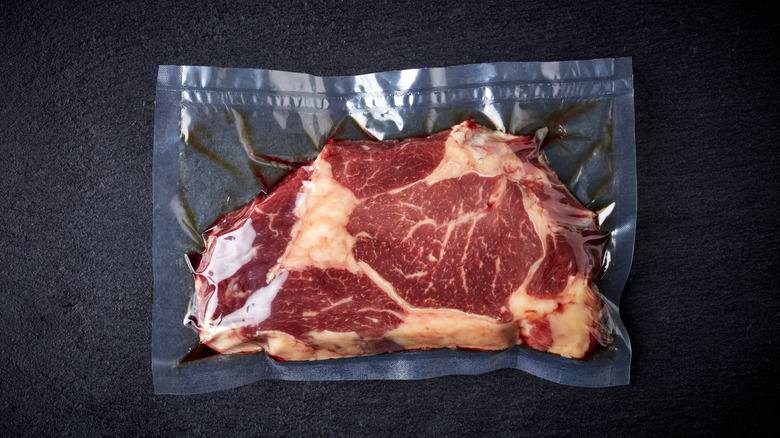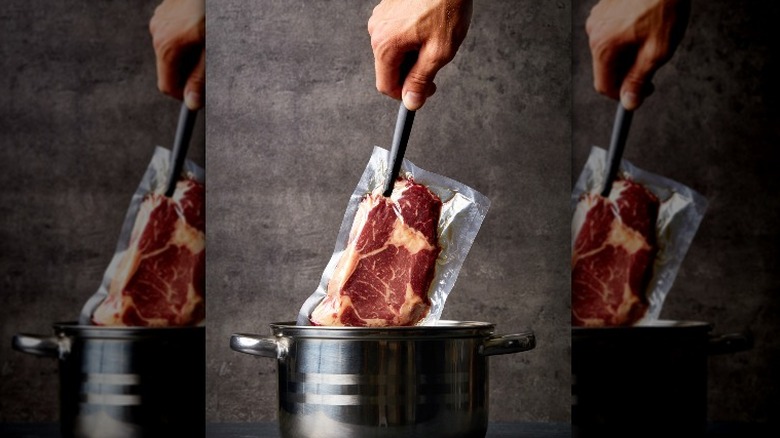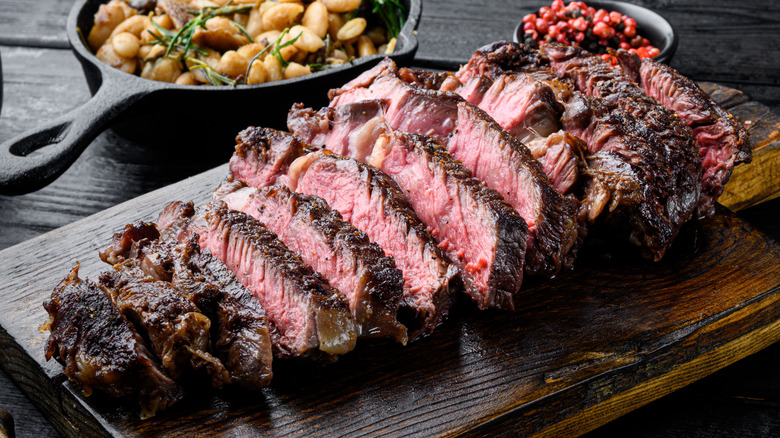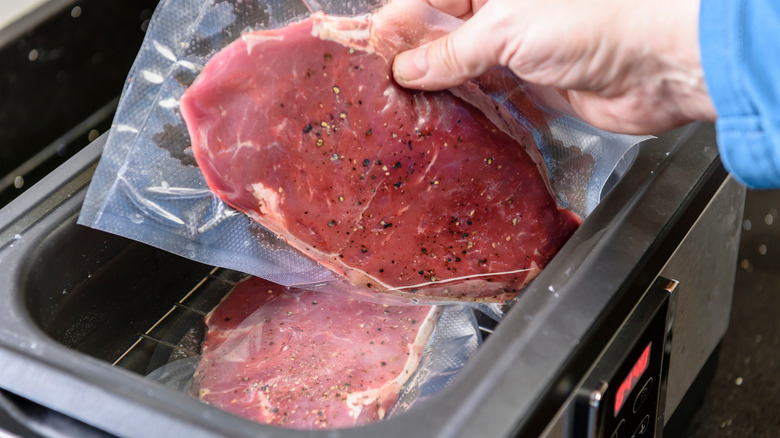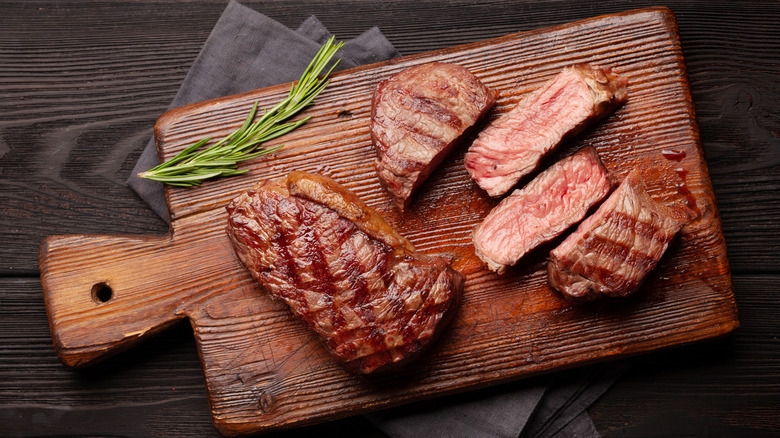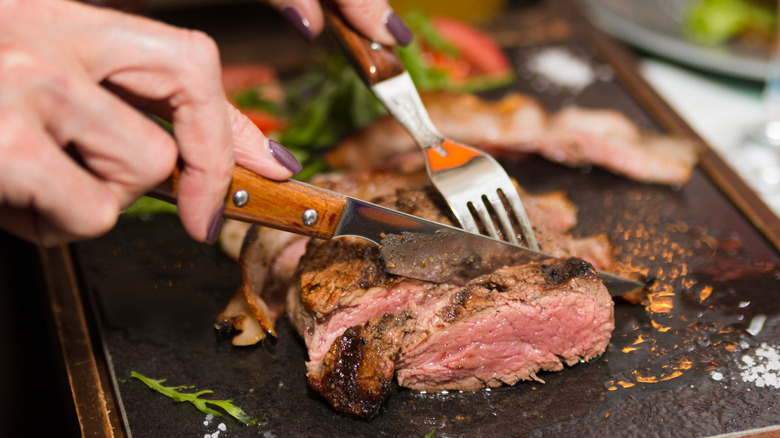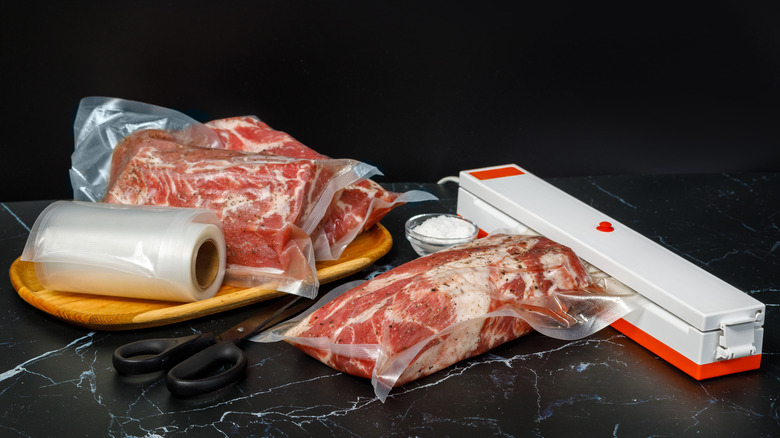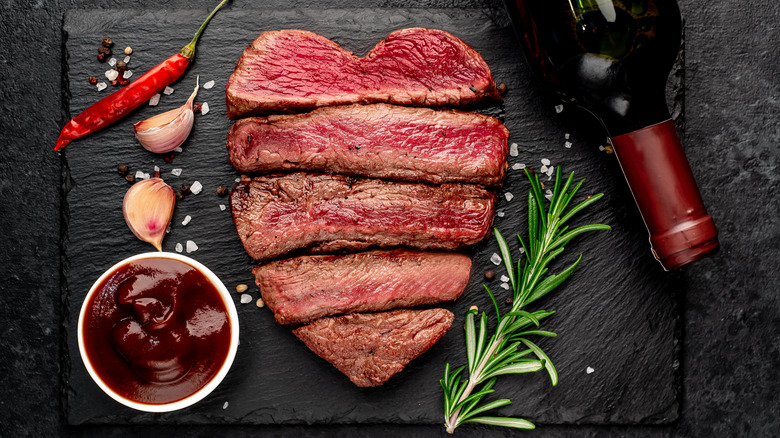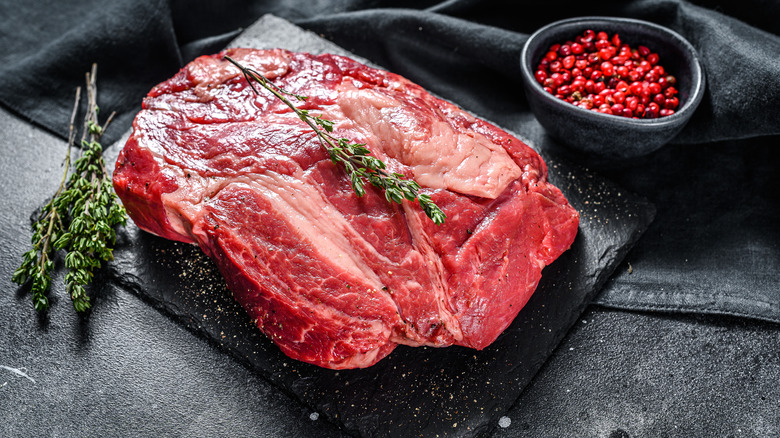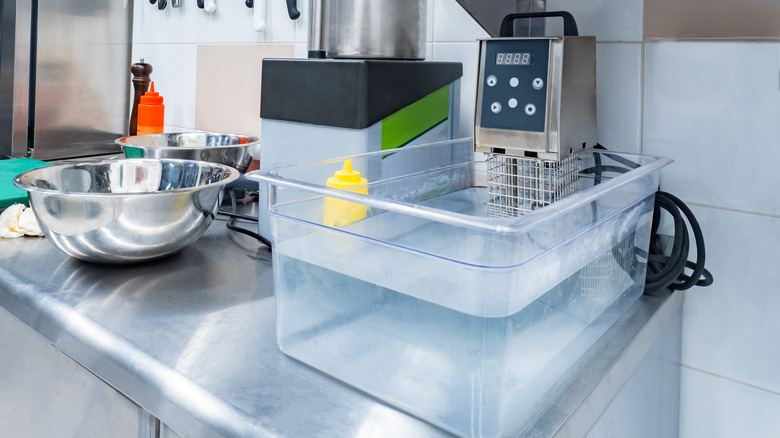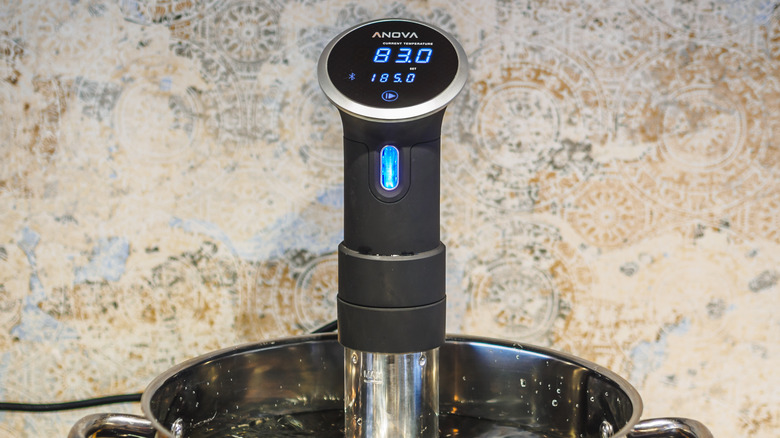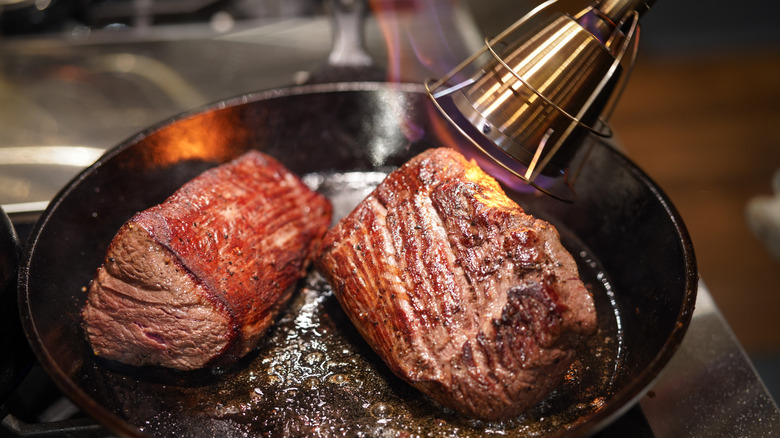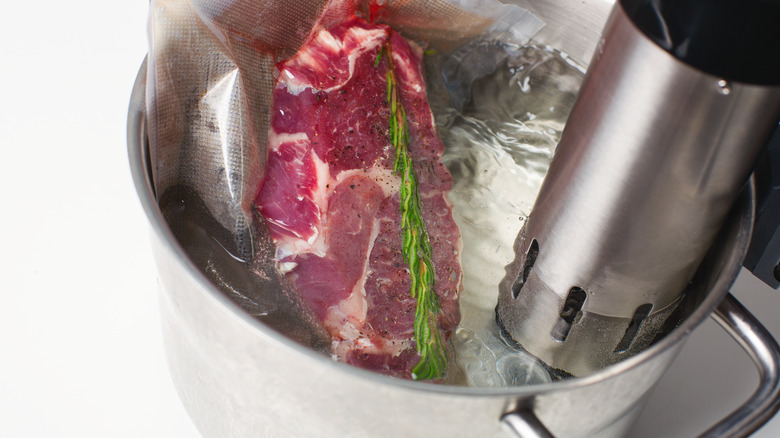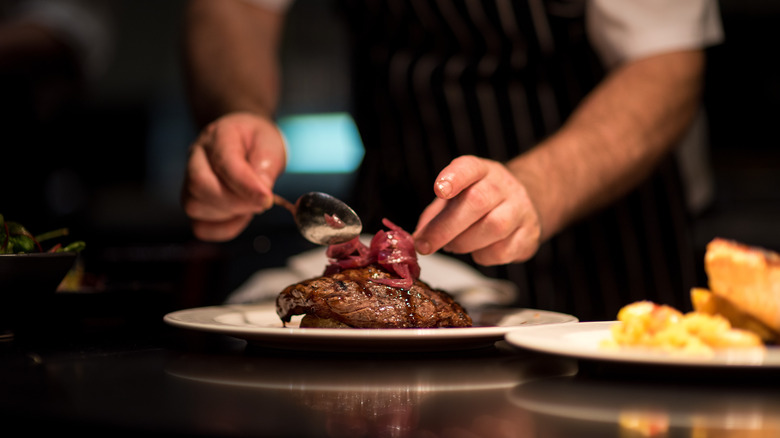The Truth About Sous Vide Steak
You've probably heard about the sous vide cooking method, even if you've never tried it for yourself. Once upon a time, this French cooking method, which means "under vacuum," was relegated to professional chefs only, as sous vide cooker manufacturer Anova Culinary points out. But now, thanks to new options that make this technology more accessible, even the most novice home cook can whip up something sous vide-style from the comfort of their own kitchen. All you need is some water, the cooker, and something in which to seal the food you're cooking.
Some of the most popular foods to cook using the sous vide technique are steaks. While many home cooks find that cooking steak is a tricky process — getting the internal temperature, the sear, and the doneness level all correct — sous vide makes it (reportedly) easy. On the surface, it looks like you can simply set your steaks to cook and then forget them, making sous vide basically the slow cooker of steak.
But is a solution like this too good to be true? Here's everything you need to know about sous vide steak.
What you've probably heard about sous vide steaks
Sous vide steaks have received a lot of hype. Fans of the cooking process report a whole bevy of benefits. Sous vide cooking gives you, as Serious Eats says, "unparalleled control over your steak." No longer are you confined to the stovetop or grill. No longer are you at the mercy of the flame and your favorite thermometer. Instead, you can accurately pick the doneness level and temperature of your steak and be assured to hit it every time, achieving an even amount of cooking throughout the entire cut of meat.
However, despite these benefits of cooking your steak sous vide-style, there are also a lot of cons to the process. Sous vide cooking takes a lot of time. The equipment isn't exactly something you likely already have on hand. The cooking experience isn't the same at all.
So, at the end of the day, you'll need to decide for yourself if the pros outweigh the cons, or vice versa. We're just here to give you the cold, hard facts.
Sous vide gives you an exact level of doneness
It is true that sous vide cooking does indeed give you the exact level of doneness that you want for your steak. While you might struggle with getting the perfect medium interior temperature while not overcooking your steak on the stovetop, that's not a worry with your sous vide immersion circulator. Why? Because the sous vide cooking machine works by heating your water bath to the precise temperature desired and then circulating the water around your steak, heating it and slow-cooking it from every angle without overcooking the exterior (like you might with a grill or cast-iron skillet) (via the Milwaukee Journal Sentinel).
Really, the only way you can ever overcook your steak when using the sous vide method, whether the interior or the exterior, as Digital Trends reports, is if you fail to follow your sous vide machine's or your recipe's instructions. You can also overcook it if you introduce too much "extra" cooking after the sous vide process, such as if you go to sear your steaks on the grill after they're finished and then leave them on the grill too long.
Sous vide steaks can be left in the cooker
One thing that sous vide aficionados love about the process is that you can just leave your sous vide cooker unattended, go about your day, and come back to the cooker when you're ready to eat. In fact, some recipes even recommend you leave your cooker running for up to 48 hours if you're cooking a particularly large piece of meat that you want fall-off-the-bone tender, such as ribs (via Home Kitchen Talk).
When cooking sous vide steaks, you can leave the steaks in your cooking water as long as you want to, without worrying about overcooking. When you're ready to eat, just remove the steaks, sear if desired, and chow down. The immersion circulator keeps the water at exactly the right temperature to keep your steak at the doneness level you want, without overcooking it or even allowing it to go cold.
The only thing you'll want to do if you leave your sous vide steak unattended is follow a few basic safety precautions. This includes keeping the water out of reach of kids and pets, keeping it away from anything flammable, and covering the water so that it doesn't evaporate too much.
Sous vide steaks are more evenly cooked
Sure, a sous vide steak is going to be cooked to your exact preferred level of doneness, but how does that doneness differ from end to end, side to side? Normally, when you cut into a steak, you'll see a color gradient. The steak is darker near the edges and pinker toward the center. That's why, in order to judge the true doneness of a steak, you'll either cut into the middle portion, or you'll stick a thermometer somewhere around the middle.
With sous vide steaks, that gradient doesn't exist. As Anova Culinary explains, when cooking a steak to medium-rare using a traditional method, by the time you get to that medium-rare temperature of 130 degrees Fahrenheit in the middle of the steak, the steak will be around 145 degrees closer to the outside, 160 degrees even closer to the outside, and then 200 degrees on the actual exterior. With a sous vide steak, the entirety of the steak, inside and out, every square inch, will be 130 degrees, thanks to the circulating water bath's consistent temperature.
Sous vide steaks don't need to rest
If you frequently cook meat of any type, you know the importance of letting your meat rest. The resting process allows for carryover cooking, which brings your steak further to your desired temperature (which is why it's so important to take your steak off the heat just a few seconds before it reaches your desired doneness). It also ensures that all of your steak's juices redistribute throughout the entire cut of meat, as we explain in a previous Mashed article on steak doneness and temperature.
Sous vide steaks don't need this resting process, because they've already been exposed to exactly the temperature you want for your desired doneness level, and they won't continue cooking after you remove them from the water if you place them in an ice bath (which is easy to do since the steaks will already be in vacuum-sealed bags). Also, the gently-heated circulating water keeps all of that moisture from moving around inside your steak (via Kitchen Swagger). You already have the doneness level you want, as well as the moisture you want, so why wait to eat?
You don't need a vacuum sealer
Yes, you do need to put your steaks into some kind of container before immersing them in the sous vide water bath, but you don't need to invest in a pricey vacuum sealing contraption in order to do so (via Home Kitchen Talk). While vacuum bags work the best, you can actually rig up a Ziplock bag to perform the same function. Just choose a BPA-free, thick Ziploc bag, place your food into it, and close it. You can secure the top of the bag further with a clip. Then, when you drop the bag into your water bath, just secure the side of the bag (the top side, where the zipper is) to the edge of the pot, ensuring that all of your food is completely submerged in the water.
Of course, you will see some differences if you use this shortcut versus going with the recommended vacuum sealed sous vide bags. The vacuum sealing helps your steak retain moisture, and also helps it retain any seasonings that you add to the bag before cooking.
Sous vide steaks are safe to eat
Sous vide recipes usually ask you to cook your steak at a low temperature, very slowly. These low temperatures have prompted some to question the safety of sous vide steaks from a food-borne illness standpoint. After all, the USDA doesn't approve of cooking steak to less than 145 degrees Fahrenheit, and extra-rare, rare, and medium-rare steaks are known to carry dangerous bacteria deep within their interiors, where the searing process and hot temperatures won't typically kill bacteria, as we have already noted.
However, Cook's Illustrated explains that the precision and control that the sous vide method allows for gives you a greater level of food safety. The publication recommends cooking sous vide steaks at or above 130 degrees Fahrenheit, as this will kill most bacteria, and since sous vide cooking ensures your steak reaches the same temperature all throughout the cut, you can rest easy knowing there's a lower chance that uncooked, living bacteria are lurking within your steak's cooler interior.
Sous vide works best with thicker steaks
You can opt for any cut of steak when cooking via the sous vide method, but, generally, the thicker the steak, the better.
You may have already experienced the problem that comes with cooking a too-thin steak over a flame. The interior becomes overly dry before you can develop a good sear. Since your sous vide steak will be cooked to perfection with no searing whatsoever before you remove it from the water bath, that extra thickness will protect your steak's interior from drying out when you do go to sear it on the stovetop afterward (which most cooks recommend in order to get that traditional seared steak flavor and texture).
Serious Eats advises purchasing steaks that are at least 1.5 inches thick, or even 2 inches, and about 12 to 16 ounces. If this seems like too large of a portion for your appetite, simply share the steak — you'll be glad you opted for the larger size when you have a steak that's the perfect temperature and moisture level inside, while also sporting a great sear on the outside.
Sous vide cooking can be pricey, but it doesn't have to be
The trendiest, latest, and greatest cooking tech is often pricey, and sous vide has been a method mostly relegated to professional chefs. It's easy to assume that sous vide equipment would be on the more expensive side ... right?
Well, not necessarily. According to Kitchen Snitches, while several years ago you would be paying $1,000 or $2,000 for a sous vide water bath, circulator, and vacuum bag sealer (which we already discussed isn't necessary), you can now purchase all the equipment you need for under $1,000. The cooking blog notes that a water bath tub can be found for as little as $300, while the circulator can go for just $70. However, some even say you don't need the water tub at all. You can just use the circulator and attach it to a large cooking pot or, in some cases, even a cooler.
Sous vide cooking does take longer
Let's say you get home from a long day of work on a Friday and you want to kick off the weekend right. You pour yourself a cocktail and decide to make some steaks for dinner. If you throw those steaks on the grill, you could be looking at a very short window of time between your prep and putting dinner on the table, less than half an hour. If you decide to use your sous vide setup, however, you'll be waiting a lot longer for your steak.
According to Kitchen Swagger, it will take about an hour to cook a steak that's 1 to 2 inches thick, though some will leave their steaks in the water bath for up to three hours. If you go with a smaller steak, you can get away with just a 40-minute cook time. However, you also have to factor in the time it will take you to sear the steak after you fetch them from the water bath, so add on another 10 minutes or so — and trust us, you want that sear. Here's why.
Un-seared sous vide steaks look a little icky
Sorry, but it's just the truth. In fact, most things that you cook in your sous vide water bath will look icky unless you add some sear via another cooking method at some point during the process. Sous vide is a lot like boiling in that you get absolutely zero color on your piece of meat. Your steak, before you sear it, will look like an icky hunk of gray matter. You're going to need to sear it on the stovetop or grill grates before it'll look very appetizing.
Searing, in addition to being necessary in order to get the appetizing look you're after, is also important for the Maillard reaction. You just won't have that caramelized, smoky, cooked flavor in a sous vide steak if you don't sear it. Luckily, there are a lot of ways to add that sear, as the Sous Vide Wizard points out, including via pan searing, the oven, grill, or even a blowtorch.
Sous vide cooking isn't foolproof
While many sous vide cooking fans claim that the method is super-foolproof and that anyone can do it and produce fantastic results, that's a little bit of a stretch. As Mashed pointed out a while ago, sous vide cooking comes with its fair share of disappointments and failures. Common issues that Digital Trends notes include rubbery meat with un-rendered fat that's unappetizing at best; sous vide bags and pouches that puncture or float, making the cooking process impossible; and overcooked foods.
Yes, while everyone says it's impossible to overcook your steak in a sous vide water bath, it actually is very possible. You can easily wind up with an overcooked sous vide steak if you don't put your steak in an ice bath after you remove it, if you sear it for too long, or if you cook too thin a steak at too high a temperature.
Sous vide just doesn't feel the same
Lastly, it's worth noting that some just feel that sous vide cooking takes all of the excitement out of the cooking process. The Guardian likens sous vide to "boil in a bag" cooking, a process that removes all of the fun, as well as the senses, from the cooking experience. For those who really enjoy cooking at home, cooking comes with a lot of sights, sounds, smells, and textures — all of which are lost when you're simply throwing some ingredients into a vacuum-sealed bag and plopping it into some water for a few hours. As The Guardian notes, "No touching, smelling, tasting, listening, looking, or engaging with the food is required. Science has got your back. Sous vide has taken all the guesswork out of cooking. It has also sucked out its soul."
So, before you jump onto the sous vide trend, take that into consideration. Is cooking at home a pleasurable process for you, an experience that you fully enjoy — or are you just trying to get a good meal on the table?
